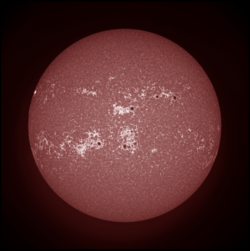Astronomy:Solar facula
From HandWiki
Short description: Photospheric phenomenon
This article's factual accuracy is disputed. (December 2023) (Learn how and when to remove this template message) |

Solar Dynamics Observatory 1700 angstrom imagery, collected near solar maximum (April 2014). The small dark regions are sunspots and the brighter speckled regions around them are faculae.
Solar faculae are bright spots in the photosphere that form in the canyons between solar granules, short-lived convection cells several thousand kilometers across that constantly form and dissipate over timescales of several minutes.
Faculae are produced by concentrations of magnetic field lines. Strong concentrations of faculae appear in solar activity, with or without sunspots. The faculae and the sunspots contribute noticeably to variations in the solar constant. The chromospheric counterpart of a facular region is called a plage.[1][2][3][4]
References
- ↑ Keller, C. U.; Schssler, M.; Vgler, A.; Zakharov, V. (20 May 2004). "On the Origin of Solar Faculae". The Astrophysical Journal 607 (1): L59–L62. doi:10.1086/421553.
- ↑ Solov'ev, A A; Kirichek, E A (1 February 2019). "Structure of solar faculae". Monthly Notices of the Royal Astronomical Society 482 (4): 5290–5301. doi:10.1093/mnras/sty3050.
- ↑ Kostyk, R. I. (February 2013). "What are solar faculae?". Kinematics and Physics of Celestial Bodies 29 (1): 32–36. doi:10.3103/S0884591313010030.
- ↑ Hirzberger, J.; Wiehr, E. (August 2005). "Solar limb faculae". Astronomy & Astrophysics 438 (3): 1059–1065. doi:10.1051/0004-6361:20052789.
 |


